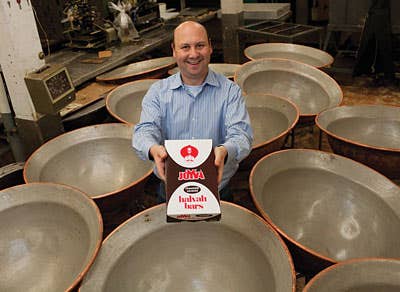
At this time of year, the Joyva Corporation, a New York City confectionary company founded in 1907 by a Ukrainian immigrant named Nathan Radutzky, does a brisk business in Jell Rings, Cherry Twists, and other candies labeled "kosher for Passover." Joyva's halvah doesn't carry that label—it's made from seeds, which many Jews of Eastern European descent consider to be forbidden during the holiday—but the fudgelike sesame confection, which dates back to biblical times, is nevertheless a beloved Passover treat among Sephardic Jews of Western European and Middle Eastern descent. And throughout the rest of the year, Joyva sells as much halvah as all its other candies combined. Today, the company, run by Nathan's grandson, Richard (pictured), produces, on average, 38,000 pounds of the sweet, nutty treat every week in the Brooklyn factory that Nathan built.
In one part of the facility, sesame seeds are soaked, shelled, rinsed, roasted, and crushed to make the paste known as tahini, halvah's distinctive component. (Joyva imports more sesame seeds and makes more tahini than just about any other company in the country.) In the mixing room, hunched over 60-gallon copper bowls, a dozen men punch, paddle, and knead the tahini to combine it with a taffy made of corn syrup, sugar, and egg whites, elongating and aerating the blend until the halvah holds together in sinewy strands.
"You can only get the strands when you mix by hand," says Richard Radutzky. "The art is in stretching but not breaking the strands. The halvah becomes doughlike. A nice piece of halvah will cut like fudge." A little vegetable oil poured in toward the end of the mixing helps bind everything together; then chocolate or vanilla flavoring is added, and the halvah is shipped to stores all over the world in bars, blocks, cylinders, or six-pound loaves that will be cut to order at deli counters. For its customers, Joyva has always been synonymous with this age-old sweet. "Among a certain demographic," Radutzky says, "I'm kind of a celebrity."
Keep Reading
Continue to Next Story










